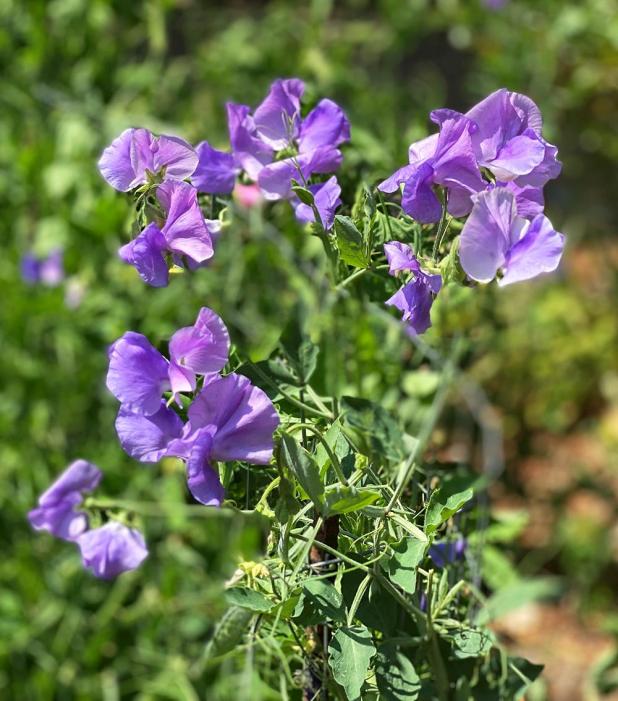
Sweet pea is a cool-season annual that blooms in spring.
—LSU AgCenter/Heather Kirk-Ballard
Get It Growing: Flowering vines in landscapes
There are many plant materials available for us to use when designing a landscape or garden. We can choose from trees, shrubs, cool- and warm-season annuals, perennials and ground covers.
And let’s not forget about vines — an element of landscapes that too often is overlooked.
For some folks, the mention of vines conjures thoughts of chaos. They are, by definition, a plant whose stem requires support and climbs by tendrils or by twining. Without supports such as trellises or stems of surrounding plants, vines creep along the ground. If not contained, they can grow into other plants.
However, vines can create unique looks by adding a vertical dimension to the landscape. Vines also can be a nice addition to small areas or patios because they don’t take up a lot of space. Growing them in containers helps contain their wild growth habit.
Many types of vines are available, including annual, perennial, evergreen and deciduous. There are those that bear flowers and even some that bear fruit. Whether you want annual or perennial vines, edible or ornamental, climbing or sprawling, there’s something for you.
—Black-eyed Susan vine (Thunbergia alata) is an herbaceous, tender perennial native to Eastern Africa that has been naturalized in other parts of the world. Flowers are typically yellow, white or orange with black centers. This continuous, long-blooming flower produces heavily in full sun and is heat tolerant. It prefers a well-drained soil.
—Carolina jessamine (Gelsemium sempervirens) is a rapidly growing, semi-evergreen vine that grows densely in landscapes. It displays beautiful yellow flowers in early spring and grows best in full to partial sun.
—Confederate or star jasmine (Trachelosp-ermum jasminoides) is an evergreen, woody, climbing perennial that is grown as a vine. It has beautiful, dark green foliage with fragrant, white flowers in spring. It has the most flowers in full sun but can tolerate heavy shade. Confederate jasmine has a moderate growth rate as it established. Keep it shaped by pruning after flowering. Be sure to provide support with arbors, fences and trellises.
—Coral honeysuckle, also known as trumpet honeysuckle (Lonicera sempervirens), is a native vine that produces clusters of tube-shaped, coral to orange-red flowers that hummingbirds love. These vines are deciduous but retain their leaves in mild winters. They prefer full sun to partial sun for the most flower production, which occurs in late summer to fall and in the spring after a mild winter. Coral honeysuckle does not provide heavy fragrance but does make a sweet nectar for pollinators. This honeysuckle is much less aggressive compared to the nonnative Japanese honeysuckle that is very fragrant, aggressive and invasive.
—Cross vine (Bignonia capreolata) is a native, climbing, woody vine reaching 50 feet long with showy, orange-red, trumpet-shaped flowers that are 2 inches long and 1 1/2 inches across. The blooms hang in clusters of two to five. Persistent, glossy, semi-evergreen leaves change from dark green in summer to reddish-purple in winter.
—Passion vine (Passiflora spp), also known as maypop, is another excellent native plant with some of the unique flowers with some producing fruit. It is a perennial, flowering vine native to the South and can be grown easily. It is drought tolerant and is the host plant for the Gulf fritillary butterfly. It produces beautiful 3-to-5-inch flowers in various shades of purple with a wavy fringe over the petals. Each flower lasts about a day during the summer and early fall. The green fruit is edible but not very tasty.
—Virginia creeper (Parthenocissus quinquefolia) is another native, easy-care vine. It has inconspicuous flowers with black berries in the fall that can be toxic to pets and small children if eaten. The Lady Bird Johnson Wildflower Center mentions the rhyme children learn to help distinguish Virginia creeper from the somewhat similar-looking and highly toxic poison Ivy (Toxicodendron radicans): “Leaves of three, let it be; leaves of five, let it thrive.” Poison ivy leaflets are normally in groups of three, while those of Virginia creeper are in groups of five. However, the deep green, glossy leaves are gorgeous, providing brilliant fall foliage color.
Here are a few more types of vines that grow well in Louisiana. Cool-season annual vines for fall and spring include sweet pea (Lathyrus odorata) and nasturtium (Tropaeolum majus), which needs cool to mild weather but will not tolerate a hard freeze.
Hardy evergreen perennial vines include English ivy (Hedera helix), akebia (Akebia quinata), fig vine (Ficus pumila) and evergreen wisteria (Milletia reticulata).
Hardy deciduous vines include trumpet creeper (Campsis radicans), native wisteria (Wisteria fruticosa), muscadine grape (Vitis rotundifolia), Chinese wisteria (Wisteria chinensis) and coral vine (Antigonon leptopus).
Confederate or star jasmine is a vine with profuse white blooms.
LSU AgCenter/Heather Kirk-Ballard
Sweet pea is a cool-season annual that blooms in spring.
Coral honeysuckle is a native vine that blooms gorgeous coral, orange and pink flowers.
